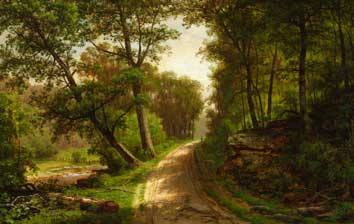In the decades following the end of the American Civil War, two generations of Pittsburgh painters spent summers sketching and painting the area in and around Scalp Level. A few miles away, Soap Hollow farmers produced simple but decorative furniture. In nearby Johnstown, potteries manufactured hand-decorated crocks and other stoneware containers for home use. More than a century later, all of these items are highly valued for their artistry.
During the second half of the nineteenth century, stunning landscape paintings by the Scalp Level School artists—George Hetzel, Eugene Alonzo Poole, Charles Linford and Alfred Wall, among others—captured the essence of the lower Stonycreek watershed's natural beauty and rural setting. Its abundant clear streams and lively waterfalls, dark hemlock forests and startling birch trees, modest farms and quiet country lanes, not to mention dazzling array of seasonal colors, stood in sharp contrast to the increasingly gritty industrial landscapes of Pittsburgh, the Mon Valley, and even nearby Johnstown. To learn more about the landscape at the time of the Scalp Level artists and how it has changed since then,
click here.
At the same time the Stonycreek Valley was a destination for landscape artists, it was also home to artisans who created utilitarian but decorative items. Amish-Mennonite farmers living along Soap Hollow Road in Conemaugh Township, Somerset County, hand-crafted decorated chests and other household furniture from locally harvested wood.
In Johnstown, several pottery firms, the most notable of which was operated by the Swanks, used locally sourced clay to manufacture a wide variety of painted stoneware crocks, jugs, and other containers used in food preservation. Today Soap Hollow furniture and Johnstown stoneware are highly prized as examples of nineteenth century regional folk art.
We are honored to display examples of these remarkable works of fine art and folk art, courtesy of generous private collectors and four Western Pennsylvania museums: the Carnegie Museum of Art, Pittsburgh; the Johnstown Area Heritage Association, Johnstown; the Southern Alleghenies Museum of Art, Loretto; and the Westmoreland Museum of American Art, Greensburg. The paintings, furniture and stoneware are accompanied by brief interpretative notes, and short biographies of the painters are also provided.
Photo credits, left to right (above):
Charles Linford (1846-1897).
The Afterglow, 1887. Oil on canvas, 24" x 36"
Collection of the
Westmoreland Museum of American Art, Greensburg, PA
Gift of the Constance Mellon Bequest, 1985.17
Blanket Chest, attributed to Peter K. Thomas (1838-1907), 1887. Private Collection. Photo credit: Rick Povich.
Swank Casserole Dish, nd. Collection of the Johnstown Area Heritage Association, Johnstown, PA
Back to Top


